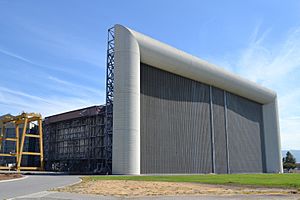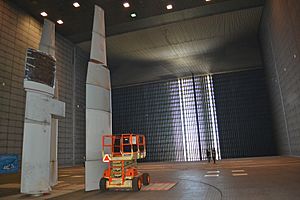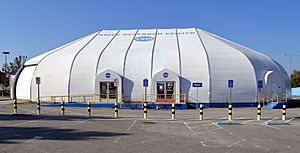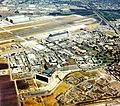Ames Research Center facts for kids
 |
|
 |
|
 Aerial view of Moffett Field and Ames Research Center |
|
| Agency overview | |
|---|---|
| Formed | December 20, 1939 |
| Jurisdiction | U.S. federal government |
| Headquarters | Mountain View, California, U.S. |
| Agency executive |
|
| Parent agency | NASA |
| Website | www.nasa.gov/ames |
| Map | |

Map of NASA Ames Research Center
|
|
The Ames Research Center (ARC), also known as NASA Ames, is a big NASA research center. It is located at Moffett Federal Airfield in California's Silicon Valley. This center was started in 1939. Back then, it was the second lab for the National Advisory Committee for Aeronautics (NACA). Later, in 1958, NACA became part of the new National Aeronautics and Space Administration.
NASA Ames is named after Joseph Sweetman Ames, a physicist who helped create NACA. Today, NASA Ames has over $3 billion worth of equipment. About 2,300 scientists and researchers work there. They have a budget of $860 million each year.
Ames first focused on studying how propeller planes fly using wind tunnels. But now, it also works on spaceflight and computer technology. NASA Ames helps with many NASA missions. It leads research in areas like finding life in space (astrobiology), small satellites, and exploring the Moon with robots. They also work on finding planets that could support life. Other key areas include supercomputing, smart computer systems, and special heat shields for spacecraft. Ames also uses planes to study space. Plus, they create tools to make air travel safer and more efficient. The current director of the center is Eugene Tu.
Ames is a main center for several important missions. These include the Kepler mission, the Stratospheric Observatory for Infrared Astronomy (SOFIA), and the Interface Region Imaging Spectrograph. It also helps a lot with the Orion crew exploration vehicle.
Contents
- What Space Missions Does Ames Help With?
- Pioneer Missions to Space
- Lunar Prospector: Searching for Moon Water
- GeneSat-1: Tiny Satellite, Big Science
- LCROSS: More Moon Water Hunting
- Kepler Mission: Finding Earth-like Planets
- SOFIA: Flying Telescope
- IRIS: Studying the Sun's Atmosphere
- LADEE: Exploring the Moon's Thin Atmosphere
- Ames' Role in Mars Missions
- How Ames Helps Air Traffic
- How Ames Uses Computers and AI
- How Ames Processes Images
- Wind Tunnels: Testing How Things Fly
- Arc Jet Complex: Testing Heat Shields
- Range Complex: Impact and Flight Testing
- United States Geological Survey (USGS)
- Education: Learning at Ames
- Recent Discoveries and Events
- Working with Other Organizations
- Living and Working at Ames
- Images for kids
- See Also
What Space Missions Does Ames Help With?
Even though Ames is a research center, not a flight center, it has been very involved in many space missions.
Pioneer Missions to Space
The Pioneer program included eight successful space missions from 1965 to 1978. Charles Hall at Ames managed these missions. At first, they explored the inner Solar System. By 1972, Pioneer 10 and Pioneer 11 flew past Jupiter and Saturn. These missions were like trailblazers. They helped scientists learn about radiation in space, discover new moons, and use gravity to help spacecraft travel faster. This information was very useful for planning the more complex Voyager 1 and Voyager 2 missions, which launched five years later. In 1978, the Pioneer program returned to the inner solar system. The Pioneer Venus Orbiter and Multiprobe missions orbited Venus instead of just flying by.
Lunar Prospector: Searching for Moon Water
Lunar Prospector was NASA's third mission in the Discovery Program. It cost $62.8 million. This 19-month mission orbited the Moon very close to its poles. It mapped the Moon's surface and looked for ice near the poles. It also measured magnetic and gravity fields. Scientists used data from Lunar Prospector to confirm that there is water ice in craters near the Moon's poles. The mission ended on July 31, 1999. The orbiter was guided to crash into a crater near the Moon's south pole. This was an attempt to turn the ice into vapor so telescopes on Earth could study it, but it didn't work.
GeneSat-1: Tiny Satellite, Big Science
The GeneSat-1 satellite weighed only 11 pounds (5 kg). It carried bacteria inside a tiny lab. It launched on December 16, 2006. This very small NASA satellite showed that scientists can quickly design and launch new, cheap spacecraft. And they can still do important science with them.
LCROSS: More Moon Water Hunting
The Lunar Crater Observation and Sensing Satellite (LCROSS) mission also looked for water on the Moon. It was a 'secondary payload spacecraft'. This means it launched on the same rocket as another mission, the Lunar Reconnaissance Orbiter (LRO). LRO is still doing different tasks on the Moon. LCROSS launched in April 2009 from Kennedy Space Center, Florida.
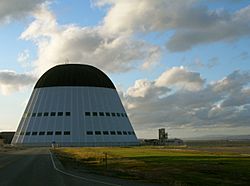
Kepler Mission: Finding Earth-like Planets
The Kepler mission was NASA's first mission that could find planets the size of Earth or even smaller. The Kepler mission watched the brightness of stars. It looked for planets that passed in front of their stars during their orbits. When a planet passes in front, it's called a 'transit'. During a transit, the planet makes the star's brightness slightly dim.
SOFIA: Flying Telescope
The Stratospheric Observatory for Infrared Astronomy (SOFIA) is a project between the U.S. (NASA) and German (DLR) space agencies. It's an infrared telescope that flies high in the sky. It flies high enough to be above most of the water vapor in Earth's atmosphere. This lets it see infrared light from space more clearly. The U.S. provides the Boeing 747SP aircraft. Germany provides the infrared telescope. The plane was changed to hold the telescope and other special equipment.
IRIS: Studying the Sun's Atmosphere
The Interface Region Imaging Spectrograph mission is a partnership with Lockheed Martin. Its goal is to understand what happens at the boundary between the Sun's chromosphere and corona. This mission is part of NASA's Small Explorer program.
LADEE: Exploring the Moon's Thin Atmosphere
The Lunar Atmosphere Dust Environment Explorer (LADEE) mission was developed by NASA Ames. It successfully launched to the Moon on September 6, 2013.
Ames' Role in Mars Missions
Ames has also helped with many other missions. Most notably, it supported the Mars Pathfinder and Mars Exploration Rover missions. The Ames Intelligent Robotics Laboratory played a key role in these. NASA Ames was also a partner on the Mars Phoenix mission. This mission sent a lander to Mars to dig trenches into layers of water ice and analyze the soil. Ames is also a partner on the Mars Science Laboratory and its Curiosity rover. This next-generation Mars rover looks for signs of organic and complex molecules.
How Ames Helps Air Traffic
The Aviation Systems Division at Ames works on two main things: managing air traffic and creating very realistic flight simulations.
Making Air Travel Safer and More Efficient
Researchers are developing ideas to allow up to three times more aircraft in the national airspace than today. They focus on using automation and making sure it's safe. This division has created tools that are now used for real flights. One example is the Traffic Management Adviser, which is being used across the country.
Amazing Flight Simulators
For flight simulation, the division has the world's largest flight simulator, called the Vertical Motion Simulator. They also have a Level-D 747-400 simulator and a panoramic air traffic control tower simulator. These simulators have been used for many purposes. They helped train Space Shuttle pilots and develop future spacecraft controls. They also tested helicopter control systems and helped investigate accidents.
The center's flight simulation and guidance lab was added to the National Register of Historic Places in 2017.
How Ames Uses Computers and AI
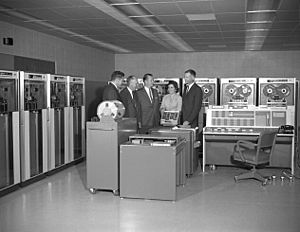
Ames is home to NASA's big research groups in Advanced Supercomputing, Human Factors, and Artificial Intelligence (AI). These groups create advanced software and systems for all of NASA's missions. This includes supporting space exploration, the International Space Station, and space science. Ames also helps run a key part of the internet's Domain Name System (DNS).
Smart Systems for Space
The Intelligent Systems Division develops advanced smart software for all of NASA's missions. They provide software for airplanes, space science missions, the International Space Station, and the Crewed Exploration Vehicle (CEV).
The first AI used in space (on Deep Space 1) was developed here. The MAPGEN software, which plans the daily activities for the Mars Exploration Rovers, also came from Ames. The same core system is used for the Phoenix Lander and for planning the International Space Station's solar arrays.
Understanding How Humans and Machines Work Together
The Human Systems Integration Division focuses on making complex aerospace systems easier and safer for humans to use. They study how people perform and interact with automated systems. This helps make big improvements in safety and mission success. This division has been a leader in human-centered aerospace research for many years.
Supercomputers at Ames
The NASA Advanced Supercomputing Division at Ames has some of NASA's most powerful supercomputers. These include Pleiades, Aitken, and Electra systems. These computers can perform quadrillions of calculations per second. Since 1987, this facility has had over 40 supercomputers. It has been a leader in high-performance computing. They developed technology used across the industry, like the NAS Parallel Benchmarks.
In 2009, Ames launched NEBULA, a fast and powerful Cloud Computing Platform. It helps NASA handle huge amounts of data securely. In 2010, NASA shared the technology behind NEBULA, called Nova, with Rackspace. This led to the creation of OpenStack. OpenStack has become one of the largest and fastest-growing open source projects in the history of computing.
How Ames Processes Images
NASA Ames was one of the first places to research how to process images from satellites. They developed some of the first techniques to improve image contrast using Fourier analysis.
Wind Tunnels: Testing How Things Fly
The NASA Ames Research Center has many wind tunnels. They are known for their huge size and for being able to do many different types of research.
ARC Unitary Plan Wind Tunnel
The Unitary Plan Wind Tunnel (UPWT) was finished in 1956. It cost $27 million. Since then, it has been NASA's most used wind tunnel. Almost every major commercial and military jet built in the United States in the last 40 years has been tested here. Models of the Mercury, Gemini, and Apollo spacecraft, as well as the Space Shuttle, were also tested in this tunnel.
National Full-Scale Aerodynamics Complex (NFAC)
Ames Research Center also has the world's largest wind tunnel. It's part of the National Full-Scale Aerodynamic Complex (NFAC). This tunnel is big enough to test full-sized airplanes, not just small models. The complex of wind tunnels was added to the National Register in 2017.
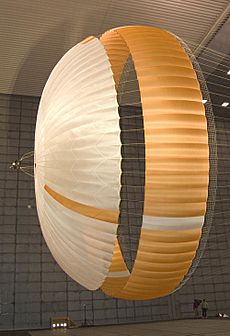
The 40 by 80 foot wind tunnel was built in the 1940s. It can create wind speeds up to 300 knots (about 345 miles per hour). It's used to study how aircraft fly, how they move, and how noisy they are. Scientists also use it to test new aircraft designs.
The 80 by 120 Foot Wind Tunnel is the world's largest wind tunnel test section. It was added in the 1980s. It can create wind speeds up to 100 knots (about 115 miles per hour). This section is used like the 40 by 80 foot section, but it can test much larger aircraft, though at slower speeds. Some tests done here include the F-18 High Angle of Attack Vehicle and the Mars Science Laboratory parachute. This huge tunnel can even test a full-size Boeing 737 plane!
NASA stopped using the NFAC in 2003. But now, the United States Air Force operates it.
Arc Jet Complex: Testing Heat Shields
The Ames Arc Jet Complex is a special facility for testing materials that protect spacecraft from extreme heat. This is important for vehicles flying at very high speeds or re-entering Earth's atmosphere. It has four different Arc Jet units. They are powered by huge electrical systems. The largest power supply can deliver 75 megawatts of power for 30 minutes. That's enough power to supply 750 homes! This allows them to test large samples under conditions similar to high-altitude flight.
The Arc Jet Complex was added to the National Register in 2017.
Range Complex: Impact and Flight Testing
Ames Vertical Gun Range
The Ames Vertical Gun Range (AVGR) was built to study how impacts happen on the Moon. This helped with the Apollo missions. It became a national facility in 1979. It is used to study how craters form.
The AVGR uses a special gun that can launch objects at speeds from 500 to 7000 meters per second (about 1,100 to 15,600 miles per hour). They can change the angle of the gun to hit targets at different angles. The target chamber is about 2.5 meters (8 feet) wide and tall. It can be made into a vacuum or filled with different gases to copy other planetary atmospheres. High-speed cameras record the impacts.
Hypervelocity Free-Flight Range
The Hypervelocity Free-Flight (HFF) Range has two active facilities. One is the Aerodynamic Facility (HFFAF). It's used to study how models fly at very high speeds. It has 16 stations that take pictures of the flying model. These pictures help scientists understand how the model moves and flies. For very high speeds (over Mach 25), models can be launched into a gas stream moving in the opposite direction.
The other facility is the Gun Development Facility (HFFGDF). It's used to improve the performance of the guns and for occasional impact tests. It uses the same types of guns as the HFFAF. It can launch objects from 3.2 to 25.4 mm (0.1 to 1 inch) in diameter. These objects can reach speeds from 0.5 to 8.5 kilometers per second (about 1,100 to 19,000 miles per hour). This facility has been used to test designs for Earth entry (like Mercury, Gemini, Apollo, and Shuttle spacecraft) and planetary entry (like Viking and Galileo).
Electric Arc Shock Tube
The Electric Arc Shock Tube (EAST) Facility studies the effects of radiation and ionization. These happen when objects enter atmospheres at very high speeds. It can also create strong shock waves in the air. The facility has a powerful capacitor system that stores 1.25 million joules of energy.
United States Geological Survey (USGS)
In 2016, the United States Geological Survey (USGS) announced it would move its West Coast science center. It's moving from Menlo Park to the Ames Research Center. This move will save money on rent.
Education: Learning at Ames
NASA Ames Exploration Center
The NASA Ames Exploration Center is a science museum and education center. It has displays and interactive exhibits about NASA technology, missions, and space exploration. You can see a Moon rock, a meteorite, and other cool samples. The theater shows movies about NASA's explorations of Mars and other planets. It also highlights the work of scientists at Ames. The center is free to visit.
Robotics Alliance Project
In 1999, Mark León started NASA's Robotics Education Project. It's now called the Robotics Alliance Project. This project has helped over 100,000 students across the country. It uses FIRST robotics and BOTBALL competitions. The project supports several highly successful robotics teams. These teams have won many competitions and awards.
The project's goal is to create human and technical resources in robotics. This helps make future robotic space exploration missions possible.
Recent Discoveries and Events
In 2006, NASA opened the Carl Sagan Center for the Study of Life in the Cosmos. This center continues the work of Carl Sagan. It includes the Search for Extraterrestrial Intelligence (SETI).
In 2008, the Lunar Orbiter Image Recovery Project (LOIRP) was given space in an old McDonald's building (renamed McMoons). They worked to digitize data tapes from the 1966 and 1967 Lunar Orbiter spacecraft that went to the Moon.
Also in 2008, former Ames director Henry McDonald was added to the Ames Hall of Fame. He was honored for his great leadership in the late 1990s.
In 2010, scientists at Ames studied the aerodynamics of the Jabulani World Cup soccer ball. They found that it tends to "knuckle under" at certain speeds. This means it moves in an unpredictable way.
In 2015, scientists at Ames announced an exciting discovery. They had created uracil, cytosine, and thymine in a lab. These are all parts of RNA and DNA. They made them without using living things, under conditions found in space.
Working with Other Organizations
The government has allowed parts of Ames to work with private companies, research groups, and schools.
HP became the first company to join a new Bio-Info-Nano Research and Development Institute (BIN-RDI). This is a partnership between the University of California Santa Cruz and NASA at Ames. This institute works to make scientific breakthroughs by combining biotechnology, information technology, and nanotechnology.
Singularity University also holds its programs at Ames. The Organ Preservation Alliance is based there too. This group works to find ways to store organs for a long time. This helps with organ transplantation.
Google's Presence at Ames
On September 28, 2005, Google and Ames Research Center announced a long-term research partnership. Google planned to build a 1,000,000 square foot (93,000 square meter) facility on the Ames campus. One project between Ames, Google, and Carnegie Mellon University is the Gigapan Project. This project creates and shares huge, detailed images of Earth. The Planetary Content Project aims to improve the data Google uses for its Google Moon and Google Mars projects. In 2008, Google leased 42 acres (17 hectares) from NASA at Moffett Federal Airfield for offices and employee housing.
Construction of Google's new project, called "Bay View," began in 2013. It is near Google's main headquarters.
In 2013, Google Inc. announced the Quantum Artificial Intelligence Lab. It is hosted at NASA's Ames Research Center. This lab has a special quantum computer. Researchers from around the world can use it. The goal is to see how quantum computing can help with machine learning.
In 2014, Google's company, Planetary Ventures LLC, leased the Moffett Federal Airfield from NASA Ames. This site is about 1,000 acres (400 hectares). This lease helps NASA save money on maintenance costs. The lease also includes restoring the historic Hangar One, as well as Hangars Two and Three. The lease started in March 2015 and lasts for 60 years.
Living and Working at Ames
You need an official NASA ID to enter Ames.
There are many activities for full-time workers and interns at the research center. There used to be a fitness trail on the base, but parts of it are now closed.
Images for kids
See Also
 In Spanish: Centro de Investigación Ames para niños
In Spanish: Centro de Investigación Ames para niños


